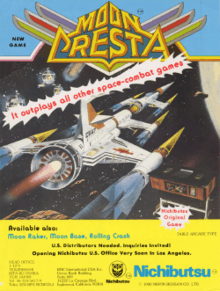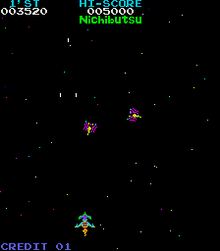Moon Cresta
Moon Cresta[lower-alpha 1] is a fixed shooter video game released in arcades in 1980 by Nichibutsu. It was licensed to Centuri who released it in arcades as Eagle. Incentive Software published ports of Moon Cresta for the Amstrad CPC, Commodore 64, Dragon 32, and ZX Spectrum.
| Moon Cresta | |
|---|---|
 North American promotional sales flyer | |
| Developer(s) | Nichibutsu |
| Publisher(s) | Nichibutsu |
| Designer(s) | Shigeki Fujiwara |
| Series | Terra Cresta |
| Platform(s) |
|
| Release | |
| Genre(s) | Fixed shooter |
| Mode(s) | Single-player, multiplayer (alternating turns) |
| Cabinet | Upright, tabletop |
| Arcade system | Namco Galaxian |
Gameplay

The player begins the game with a small spaceship armed with a single laser cannon. After successfully completing the first four waves of alien attacks, the player must attempt to dock his ship with the next 'stage' of the ship. This second stage has two lasers in addition to the original one. Each docked stage is one of the player's "lives."
After successfully clearing two more waves of aliens, the player must again dock with the third and final piece of the ship which also has two more lasers (giving the player 5 lasers in total). The trade-off for this is that the entire ship is a much larger target. Failure to correctly align the stages during either docking sequence causes the destruction of the stage being docked with.
After completing the first eight waves the player's ship reverts to the first stage and the process is repeated. If any of the player's three ships are lost along the way, the docking sequence occurs only after the first four waves have been completed. Play ends when all three of the player's ship-stages are destroyed.
Reception
| Reception | ||||||||||||||
|---|---|---|---|---|---|---|---|---|---|---|---|---|---|---|
| ||||||||||||||
Moon Cresta was a success for Nichibutsu. It helped propel them into the video game business, and is one of their most successful arcade games.[7] Computer + Video Games commented on the game's visuals for being bright and colorful, and its gameplay for being captivating.[8] Game Machine felt the same way, recognizing it as a sure-hit for arcades because of its gameplay and mechanics.[9]
The ZX Spectrum version in particular was met with average reviews. Your Spectrum said that the gameplay was close to the arcade original, but felt that it was beginning to show its age.[6] Sinclair User had a similar response, and commented that the only reason to even play it was to win a contest held by Incentive.[5] They said that the game was a good conversion of the original, but the gameplay itself was dated and not as fun as other games for the system.[5] Crash magazine was a lot more positive towards the game, awarding it a "Crash Smash" award;[3] they applauded it for its simplistic gameplay, accurate portrayal of the arcade game, and its overall addictiveness, saying: "At a time when the emphasis tends to be on complicated arcade/adventures or third generation platform games, I think it’s brave of Incentive to release an old fashioned shoot em up like this, and I’m thankful that they have. Great fun!"[3]
In 1998, Allgame said that while Moon Cresta had several unique ideas, particularly the ship docking mechanic "slick" controls, and its fast-paced action, it was ultimately hampered by its high difficulty level.[2] They said that the tough gameplay would put off a lot of players, saying: "Slick controls, distinctive graphics and almost-musical sound effects add up to a memorable package, but one which was too tough for some casual gamers to master."[2] By contrast in 2007, Eurogamer greatly praised the game for its addictive nature, creativity, and overall challenge that helped set the standard for games to follow.[4] They said: "I still, to this very day, admire Moon Cresta for being an adrenalin-fuelled, no nonsense shmup that epitomises the simplistic gaming challenges of early arcade games. Left, right and fire was all it took to take a young impressionable teenager from a world where potting the black was the challenge of the day."[4]
In a 2016 retrospective review, Hardcore Gaming 101 labeled Moon Cresta as being an influential and well-regarded shooter from the era.[7] They greatly praised the game's key differences from games like Galaxian and Galaga, such as the ship docking mechanic.[7] Hardcore Gaming 101 felt mixed towards the Super Famicom and PlayStation conversions, disliking both version's modifications to the enemy speed and other characteristics in the game, which they said might put off fans of the original.[7] Retro Gamer felt the same way about the arcade original, saying that Moon Cresta had several differences that made it stand out from Galaxian and Galaga, and that it was an entertaining and important game in its own right.[10] They praised the game's large layer of strategy and scoring, alongside the ship docking mechanic.[10] Retro Gamer concluded their review by writing: "By predating Galaga's multiple ship mechanic and introducing a range of diverse enemies, Moon Cresta is rightfully regarded as a key stage in the development of arcade shooters.[10]
Legacy
Moon Cresta spawned a long series of sequels, spin-offs and alterations for dozens of other platforms. The first of these was Eagle, produced by North American game distributor Centuri, which changes most of the visuals and adds a new eagle-shaped enemy.[10] Gremlin Industries followed it with Super Moon Cresta, a modification kit that allows the enemies to fire back at the level and changes some of the text.[10] Nichibutsu itself created Moon Quasar, a spin-off that gives the second ship more firepower and a brief "refueling" segment, where the player must dock their vessel into a mothership towards the center of the screen.[10]
A true sequel to Moon Cresta was released in 1985, titled Terra Cresta. It features radically different gameplay from its predecessors, being a vertical-scrolling game where players must collect different ship pieces that each provide a new weapon, which can also be separated to use a secondary weapon.[11] Another spin-off game, UFO Robo Dangar, was released in 1986 that was similar to Terra Cresta, only the player controls a giant mecha instead of a starship.[12] In 1987, Nichibutsu released Terra Force, which adds horizontal-scrolling segments alongside the vertical-scrolling ones from Terra Cresta.[13] A direct sequel to Terra Cresta, titled Terra Cresta II: Mandler no Gyakushu, was released in 1992 for the PC Engine in Japan, adding new stage designs, additional bosses, and more weapons and power-ups to use.[14] A 3D follow-up, Terra Cresta 3D, was released in 1997 for the Sega Saturn, being one of Nichibutu's final games;[15] it serves as a 3D update to Terra Cresta, with new stages and weapon types.[16]
Notes
References
- "Coin Machine - Manufacturers Equipment". Cash Box. 19 September 1980. p. 37. Retrieved 29 February 2020.
- Green, Earl (1998). "Moon Cresta - Review". Allgame. All Media. Archived from the original on 16 November 2014. Retrieved 29 February 2020.
- "Moon Cresta (Trip to the Space War)" (14). Newsfield Publications Ltd. Crash. March 1985. Archived from the original on 12 July 2019. Retrieved 29 February 2020.
- Wilkins, Chris (26 October 2007). "Moon Cresta". Eurogamer. Gamer Network. Archived from the original on 9 October 2019. Retrieved 29 February 2020.
- "Spectrum Software Scene". Sinclair User (38): 28. May 1985.
- "Joystick Jury". Your Spectrum (14): 43. May 1985.
- Ragan, Jess (9 July 2016). "Moon Cresta". Hardcore Gaming 101. Archived from the original on 21 November 2019. Retrieved 29 February 2020.
- "Arcade - Moon Cresta: Keep On Docking". United Kingdom: Future Publishing. Computer & Video Games. March 1982. p. 26. Archived from the original on 2 February 2019. Retrieved 29 February 2020.
- "ムーンクレスタ" (PDF) (in Japanese). Amusement Press, Inc. Game Machine. 15 July 1980. p. 2. Archived from the original (PDF) on 20 June 2019. Retrieved 29 February 2020.
- Mason, Graeme (30 November 2018). "The Definitive Moon Cresta" (175). United Kingdom: Imagine Publishing. Retro Gamer. pp. 38–43.
- Ragan, Jess (9 July 2016). "Terra Cresta". Hardcore Gaming 101. Archived from the original on 21 November 2019. Retrieved 29 February 2020.
- "Dangar Ufo Robo". Killer List of Videogames. The International Arcade Museum. Archived from the original on 25 March 2019.
- "Arcade Action - Terra Force". United Kingdom. Computer & Video Games. January 1988. p. 151. Archived from the original on 2 February 2019. Retrieved 29 February 2020.
- Ragan, Jess (13 August 2016). "Terra Cresta II". Hardcore Gaming 101. Archived from the original on 17 April 2019. Retrieved 16 November 2019.
- Ragan, Jess (21 August 2016). "Terra Cresta 3D". Hardcore Gaming 101. Archived from the original on 7 May 2019. Retrieved 16 November 2019.
- "Terra Cresta 3D" (36). Next Generation. December 1997. p. 168. Retrieved 16 November 2019.
External links
- Moon Cresta at the Killer List of Videogames
- Moon Cresta at SpectrumComputing.co.uk